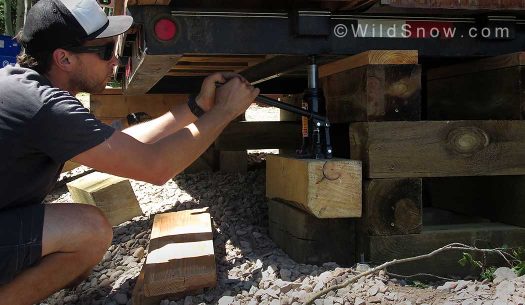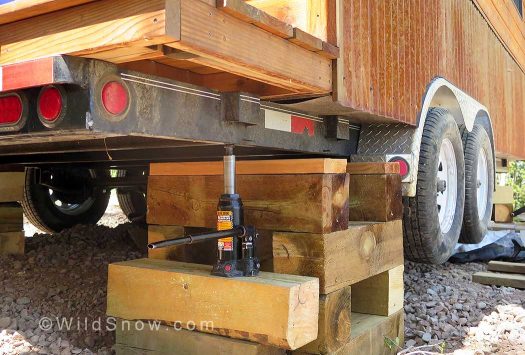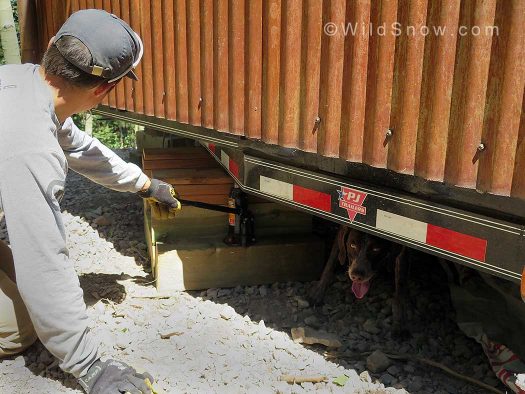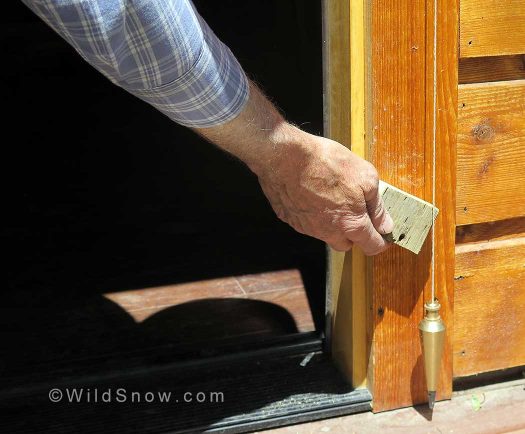
Leveling the tiny. This photo shows the temporary jack support, and permanent-temporary cribbing being built up to the right.
Give me a ‘Tube vid and a few tools, and stand aside. Instant expert! I’m beginning to feel like a tiny house ski cabin guru, having installed two more of them than most people ever will. DIY-Fun.
Honestly, I do have some experience with this sort of thing. Back in my construction days myself and crew lifted a few houses ourselves. I worked with house moving experts on a couple of others. Six years in a mobile home that required leveling and remodeling helps the knowledge base as well.
Since a tiny house already has “support beams” in the form of a trailer, it’s easy to lift. Most important trick is to use 4 identical bottle jacks, one under each corner. For support we like 6×6 inch cribbing chunks cut from treated landscape timbers. Have plenty of those on hand and build crisscross “pallets” under each corner (locate these a few feet in towards the trailer axles, to avoid any tendency for the frame to sag), with temporary blocking under the jacks.
Level all the support material carefully, including the jack blocks, to prevent things from going south, or north (code words for “sideways” and down). Be safe and aware, for example “safety” the trailer with temporary supports while leaving wheels, tires and tongue jack installed as backup in case a jack fails. As much as possible stay out from under the trailer while you’re working.
As you work, pin the cribbing together with angled “toe screws” so it doesn’t move around while unweighted.
My other favorite trick is to use a couple of plumbobs hung on walls for the leveling instrumentation, and for long-term installs perhaps even use a water level to check the trailer frame. I’m fond of calling this “Egyptian technology” as it always makes me think of guys building the Great Pyramid of Giza. I’m told that to get their pyramid foundations perfectly level, the Pharaoh’s employees filled their starter pit with water and built to the water level for phenomenal accuracy. My kit includes a laser level as well, but I find the low tech plumbobs are easier in this application. Working to 1/8 inch tolerance with the plumbobs hung at nearly full wall height seems adequate, and probably exceeds how “true” many residential structures are.
Additional tools: A 24 inch stick “bubble” level is necessary for leveling the blocking and doing quick checks. An even shorter “torpedo” level is useful as well, especially if equipped with a magnet so you can stick it on the trailer frame.
Plumbob shopping? Heavier 16 ounce type is often better, keeps drafts from moving it. But the 8 ounce versions are nice as well.
Final test is if a cigarette rolls off the kitchen counter or not. Wait, that’s the test for a rodeo camping trailer. A ski touring camping shelter leveling test involves a beer bottle resting sideways on the floor. If it rolls, do better.

Bottle jack on temporary pad, crisscross cribbing is temp as well, only less so. For final leveling we used chunks of 2×6 and 1x wood, topped with steel foundation wall shims when tiny adjustments were necessary.

Using identical jacks is smooth. You can count the number of strokes that lift a certain amount and use that knowledge to great effect. Or, for example in the situation of needing to raise one side that’s already level from left to right, you can pump the two associate jacks equally. Cheapo ‘6 ton’ or ‘4 ton’ from the big box store or Amazon work well, be sure they’re all properly filled with fluid. You might be tempted by inexpensive ‘2 ton’ versions, in my experience they’re too weak and don’t have enough throw to be useful.

The plumbobs are strung from 2×4 blocks, so another block can be used as a spacer to quickly check how close you are.
WildSnow.com publisher emeritus and founder Lou (Louis Dawson) has a 50+ years career in climbing, backcountry skiing and ski mountaineering. He was the first person in history to ski down all 54 Colorado 14,000-foot peaks, has authored numerous books about about backcountry skiing, and has skied from the summit of Denali in Alaska, North America’s highest mountain.

